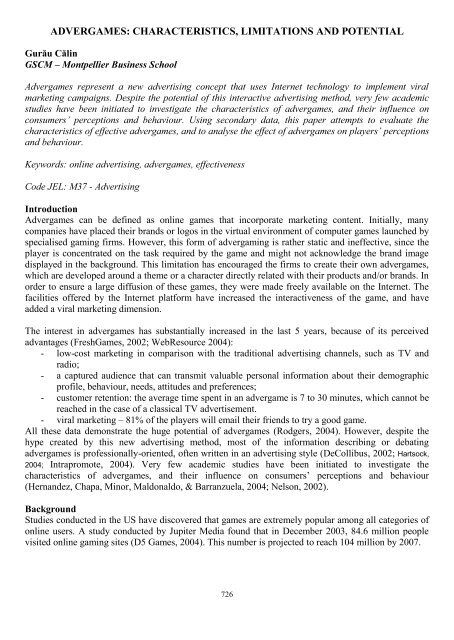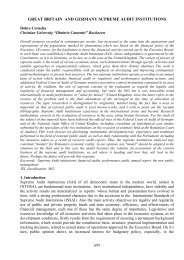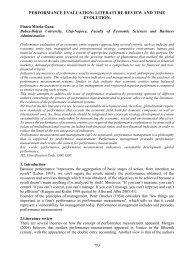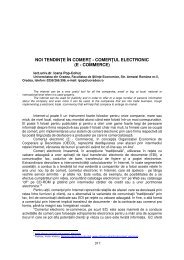ADVERGAMES: CHARACTERISTICS, LIMITATIONS AND POTENTIAL
ADVERGAMES: CHARACTERISTICS, LIMITATIONS AND POTENTIAL
ADVERGAMES: CHARACTERISTICS, LIMITATIONS AND POTENTIAL
- No tags were found...
Create successful ePaper yourself
Turn your PDF publications into a flip-book with our unique Google optimized e-Paper software.
<strong>ADVERGAMES</strong>: <strong>CHARACTERISTICS</strong>, <strong>LIMITATIONS</strong> <strong>AND</strong> <strong>POTENTIAL</strong>Gurău CălinGSCM – Montpellier Business SchoolAdvergames represent a new advertising concept that uses Internet technology to implement viralmarketing campaigns. Despite the potential of this interactive advertising method, very few academicstudies have been initiated to investigate the characteristics of advergames, and their influence onconsumers’ perceptions and behaviour. Using secondary data, this paper attempts to evaluate thecharacteristics of effective advergames, and to analyse the effect of advergames on players’ perceptionsand behaviour.Keywords: online advertising, advergames, effectivenessCode JEL: M37 - AdvertisingIntroductionAdvergames can be defined as online games that incorporate marketing content. Initially, manycompanies have placed their brands or logos in the virtual environment of computer games launched byspecialised gaming firms. However, this form of advergaming is rather static and ineffective, since theplayer is concentrated on the task required by the game and might not acknowledge the brand imagedisplayed in the background. This limitation has encouraged the firms to create their own advergames,which are developed around a theme or a character directly related with their products and/or brands. Inorder to ensure a large diffusion of these games, they were made freely available on the Internet. Thefacilities offered by the Internet platform have increased the interactiveness of the game, and haveadded a viral marketing dimension.The interest in advergames has substantially increased in the last 5 years, because of its perceivedadvantages (FreshGames, 2002; WebResource 2004):- low-cost marketing in comparison with the traditional advertising channels, such as TV andradio;- a captured audience that can transmit valuable personal information about their demographicprofile, behaviour, needs, attitudes and preferences;- customer retention: the average time spent in an advergame is 7 to 30 minutes, which cannot bereached in the case of a classical TV advertisement.- viral marketing – 81% of the players will email their friends to try a good game.All these data demonstrate the huge potential of advergames (Rodgers, 2004). However, despite thehype created by this new advertising method, most of the information describing or debatingadvergames is professionally-oriented, often written in an advertising style (DeCollibus, 2002; Hartsock,2004; Intrapromote, 2004). Very few academic studies have been initiated to investigate thecharacteristics of advergames, and their influence on consumers’ perceptions and behaviour(Hernandez, Chapa, Minor, Maldonaldo, & Barranzuela, 2004; Nelson, 2002).BackgroundStudies conducted in the US have discovered that games are extremely popular among all categories ofonline users. A study conducted by Jupiter Media found that in December 2003, 84.6 million peoplevisited online gaming sites (D5 Games, 2004). This number is projected to reach 104 million by 2007.726
The preconception that only kids or teenagers are interested in interactive games is contradicted by thefindings: in US 66% of the most frequent game players are over 18 years old, and 40% of them over 35years old, with the average age of a player being 28 year old (D5 Games, 2004).Another study conducted during December 2003 – January 2004 in the US, has identified the womenover 40 years old as a major segment interested in online gaming (Arkadium, 2004). The female gameplayersover 40 spend the most hours per week playing games (9.1 hours or 41% of their online time incomparison with only 6.1 hours per week, or 26% of their online time for men). These women werealso more likely to play online games every day than men or teens of either gender. The reasons forplaying online games vary depending on the gender. The main reason of women is to relieve oreliminate stress, while the men are mainly attracted by the competitive factor of Internet gaming. Thewomen prefer word and puzzle games, while men are more interested in sport, combat or casino games(Arkadium, 2004).The placement of products or brand names in movies or TV shows is a relatively old technique, but thestudies regarding their influence on consumer perceptions and behaviour are inconclusive (Gould, Pola,& Grabner-Krauter, 2000; Russell, 2002). The advergames present a few distinct characteristics that caneventually enhance their marketing effect:- the advergames are selected by the player himself/herself, and are not forced upon an unwillingviewer;- the player interacts with advergames adopting an active stance, in comparison with the passiveattitude of the TV audience;- advergames incite the players to share the gaming experience with their friends or family.From a marketing point of view, the advergames attempt to capture the attention of players, and then totransmit to them, in an indirect way, suggestions that aim to modify their perceptions regarding anenterprise, brand, or product. The psychological fundament of this process is the inducement and theuse of the ‘state of flow’. This concept is used by psychologists to describe a mental state in which theattention is highly concentrated on a specific process, the environmental information is screened out,and the person experiences a harmonious flow of its present experience (Csikszentmihalyi, 1991). Thestate of flow is known to create a state of well being, as well as increased perception and learningcapacity. This state of flow can be induced by any activity that is very interesting for a person: watchinga movie, reading a book, or playing a game. In fact, the ludic activity is considered as one of the bestinducers of the flow state for children, and often also for adults.The interaction with Internet applications can also induce the state of flow in specific circumstances(King, 2003), the most successful web sites offering interactive experiences, and not only content. Thestate of flow can be created online if the following essential conditions are combined: user motivation,user telepresence, and interactivity of the Internet application. On the other hand, the existence and themaintenance of the state of flow is a dynamic process, that depends on the relation between thecapabilities of the user – or player in the case of an advergame - and the level of difficulty proposed bythe game. Figure 1 demonstrates the three possible scenarios of the interaction between an Internet userand an advergame.727
An objective evaluation of the advergame relevance for the firm/brand/product advertised is difficult atthis stage, because it is necessary to define a number of quantifiable criteria that can describe and assessthe personality of a brand. The same type of problem is related with evaluating the capacity of the gameto induce and maintain a state of flow. In this case, an experiential approach is more suitable, althoughthe two variables defined for this characteristic are equally relevant, being derived from the relationbetween the capability of the online player, and the capacity of the advergame to propose an appropriateand dynamic level of challenge.References1. Adverblog.com (2006). Advergames archive.http://www.adverblog.com/archives/cat_advergames.htm [accessed November 2006].2. Arkadium (2004). New Study Reveals That Women Over 40 Who Play Online Games Spend FarMore Time Playing Than Male or Teenage Gamers. http://www.arkadium.com/aol_study.html[accessed November 2004].3. Bogost, I. (2005). Agency.com snowball fight. Water Cooler Games, 23 December.http://www.watercoolergames.org/archives/000506.shtml [accessed February 2007].4. Bogost, I. (2006). Free-Ad-supported Mobile Games. Water Cooler Games, 21 August.http://www.watercoolergames.org/archives/00605.shtml [accessed February 2007].5. Bogost, I. (2007). Persuasive Games: Promogames, Another Kind of Advertising Game, SeriousGame Source. http://seriousgamessource.com/features/feature_010207_burger_king_1.php[accessed February 2007].6. Csikszentmihalyi, M. (1991). Flow: The Psychology of Optimal Experience. New York: HarperPerennial.7. D5 Games (2004). Demographics of Game Players.http://www.d5games.net/advergames/demographics.php [accessed November 2004].8. DeCollibus, J. (2002). Advergames: Experiential Direct Marketing Wins Leads, Drives Traffic,Builds Brands. 360° Newsletter, 17 July.http://www.jackmorton.com/360/market_focus/july02_mf.asp [accessed December 2004].9. Frasca, G. (2007). Playing with Fire: When Advergaming Backfires, Serious Games Source.http://seriousgamessource.com/features/feature_011707_intel_2.php [accessed February 2007].10. FreshGames (2002). Why Advergames ?http://www.freshgames.com/marketing/whyadvergames.php [accessed November 2004].11. Gould, S. J., Pola B.G., & Grabner-Krauter, S. (2000). Product Placements in Movies: A Cross-Cultural Analysis of Austrian, French and American Consumers' Attitudes Toward This Emerging,International Promotional Medium. Journal of Advertising, 29(4), 41-58.12. Hartsock, N. (2004). Advergames newly viable after all these years. EMarketing IQ, 21 July.http://www.emarketingiq.com/news/1409-eMarketingIQ_news.html [accessed November 2004].13. Hernandez, M.D., Chapa, S., Minor, M.S., Maldonaldo, C., & Barranzuela, F. (2004). HispanicAttitudes toward Advergames: A Proposed Model of their Antecedents. Journal of InteractiveAdvertising, 5(1), http://www.jiad.org/vol5/no1/hernandez/ [accessed November 2004].14. Intrapromote (2004). Viral Marketing Advergames - The Campaign that Aids SEO through LinkBuilding. http://www.intrapromote.com/advergames.html [accessed November 2004].15. King, A. (2003). Optimizing Flow in Web Design. Infomit, 11 July.http://www.informit.com/articles/article.asp?p=98147 [accessed November 2004].16. Nelson, M.R. (2002). Recall of Brand Placements in Computer/Video Games. Journal ofAdvertising Research, 42(2), 80-92.17. Rodgers, Z. (2004). Chrysler Reports Big Brand Lift on Advergames. ClickZ Network, 28 July,http://www.clickz.com/news/article.php/3387181 [accessed November 2004].729
18. Russell, C.A. (2002). Investigating the Effectiveness of Product Placements in Television Shows:The Role of Modality and Plot Connection Congruence on Brand Memory and Attitude. Journal ofConsumer Research, 29(3), 306-318.19. WaterCoolerGames.com (2006). Advergames archive.www.watercoolergames.org/archives/cat_advergames.shtml [accessed November 2006].20. WebResource (2004). What is advergaming ? http://www.webresource.com.au/content/?id=12[accessed November 2004].730
















